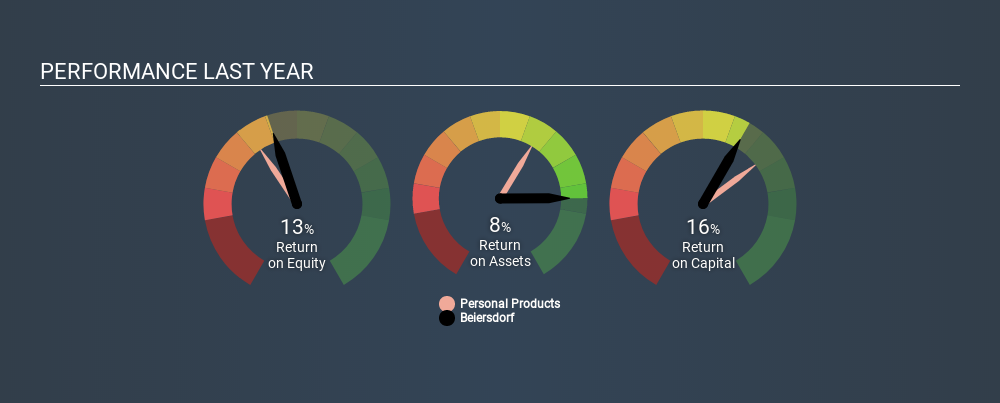- Germany
- /
- Personal Products
- /
- XTRA:BEI
Beiersdorf Aktiengesellschaft (ETR:BEI) Earns A Nice Return On Capital Employed

Today we'll evaluate Beiersdorf Aktiengesellschaft (ETR:BEI) to determine whether it could have potential as an investment idea. Specifically, we'll consider its Return On Capital Employed (ROCE), since that will give us an insight into how efficiently the business can generate profits from the capital it requires.
Firstly, we'll go over how we calculate ROCE. Then we'll compare its ROCE to similar companies. Last but not least, we'll look at what impact its current liabilities have on its ROCE.
What is Return On Capital Employed (ROCE)?
ROCE is a measure of a company's yearly pre-tax profit (its return), relative to the capital employed in the business. Generally speaking a higher ROCE is better. Ultimately, it is a useful but imperfect metric. Renowned investment researcher Michael Mauboussin has suggested that a high ROCE can indicate that 'one dollar invested in the company generates value of more than one dollar'.
So, How Do We Calculate ROCE?
The formula for calculating the return on capital employed is:
Return on Capital Employed = Earnings Before Interest and Tax (EBIT) ÷ (Total Assets - Current Liabilities)
Or for Beiersdorf:
0.16 = €1.1b ÷ (€9.4b - €2.5b) (Based on the trailing twelve months to June 2019.)
So, Beiersdorf has an ROCE of 16%.
Check out our latest analysis for Beiersdorf
Is Beiersdorf's ROCE Good?
ROCE can be useful when making comparisons, such as between similar companies. In our analysis, Beiersdorf's ROCE is meaningfully higher than the 11% average in the Personal Products industry. We consider this a positive sign, because it suggests it uses capital more efficiently than similar companies. Independently of how Beiersdorf compares to its industry, its ROCE in absolute terms appears decent, and the company may be worthy of closer investigation.
You can see in the image below how Beiersdorf's ROCE compares to its industry. Click to see more on past growth.

When considering ROCE, bear in mind that it reflects the past and does not necessarily predict the future. ROCE can be deceptive for cyclical businesses, as returns can look incredible in boom times, and terribly low in downturns. ROCE is, after all, simply a snap shot of a single year. Future performance is what matters, and you can see analyst predictions in our free report on analyst forecasts for the company.
How Beiersdorf's Current Liabilities Impact Its ROCE
Liabilities, such as supplier bills and bank overdrafts, are referred to as current liabilities if they need to be paid within 12 months. The ROCE equation subtracts current liabilities from capital employed, so a company with a lot of current liabilities appears to have less capital employed, and a higher ROCE than otherwise. To check the impact of this, we calculate if a company has high current liabilities relative to its total assets.
Beiersdorf has total liabilities of €2.5b and total assets of €9.4b. As a result, its current liabilities are equal to approximately 26% of its total assets. Current liabilities are minimal, limiting the impact on ROCE.
Our Take On Beiersdorf's ROCE
This is good to see, and with a sound ROCE, Beiersdorf could be worth a closer look. Beiersdorf shapes up well under this analysis, but it is far from the only business delivering excellent numbers . You might also want to check this free collection of companies delivering excellent earnings growth.
For those who like to find winning investments this free list of growing companies with recent insider purchasing, could be just the ticket.
If you spot an error that warrants correction, please contact the editor at editorial-team@simplywallst.com. This article by Simply Wall St is general in nature. It does not constitute a recommendation to buy or sell any stock, and does not take account of your objectives, or your financial situation. Simply Wall St has no position in the stocks mentioned.
We aim to bring you long-term focused research analysis driven by fundamental data. Note that our analysis may not factor in the latest price-sensitive company announcements or qualitative material. Thank you for reading.
About XTRA:BEI
Beiersdorf
Manufactures and distributes consumer goods in Europe, the United States, Africa, Asia, and Australia.
Flawless balance sheet with solid track record and pays a dividend.
Similar Companies
Market Insights
Community Narratives





